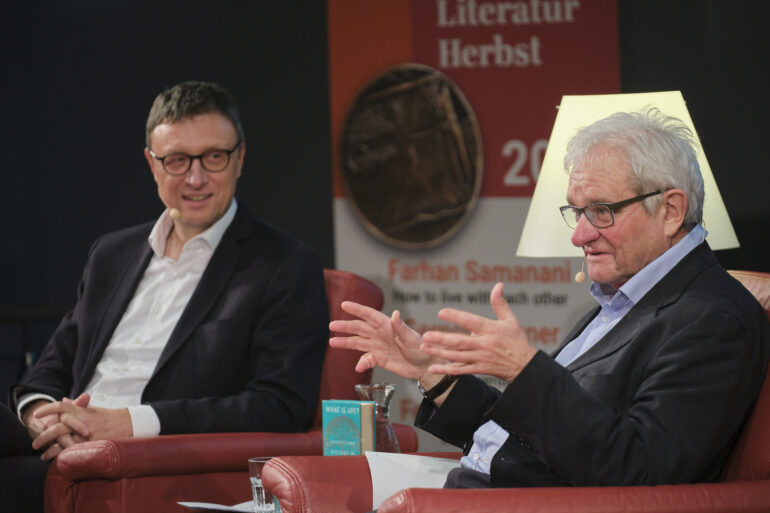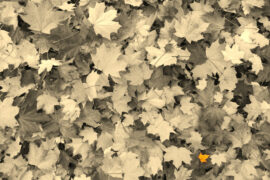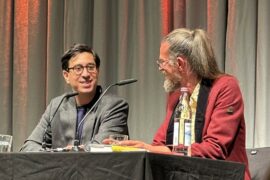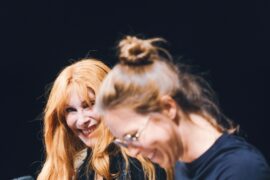In the science series at the Literaturherbst, Nobel Prize winner Paul Nurse presents his definition of ›life‹. In a humorous and understandable way, even for a non-scientist, he takes the audience into the world of biochemistry and shares some personal anecdotes.
By Arezoo Izadi and Jaeeun Kim
Picture: Martin Liebetruth
It is not every day that you have the opportunity to sit in front of a Nobel Prize winner and listen to his answer to the perennial question of »What is life?«. The Göttinger Literaturherbst offered the opportunity for precisely this: On October 30th, Sir Paul Nurse, the British biochemist and winner of the 2001 Nobel Prize in the field of Physiology or Medicine, spoke about his book, What is Life? Understand Biology in Five Steps in the Paulinerkirche. He was introduced by Patrick Cramer, President of the Max Planck Society and moderator of the evening.
The Butterfly and the Essence of Life
The question of »What is life?« is certainly not an easy one to tackle, nor a straightforward one, and as Cramer expresses during the evening, it takes great courage to explore this question and write a book about it. Nurse himself began to wonder about it when he was only twelve years old. As he shares various images on the big screen, he takes a trip down memory lane and talks about the time when, as a young boy, observing a butterfly sparked this question in his mind. He began to recognize that the butterfly was alive, just like he was, full of purposeful behaviour, and it made him wonder about what it means to be alive and, more generally, about what life is. This experience was what he looked back on from time to time as he was navigating the field of biochemistry.
The Five Themes of Life
The lecture then proceeds according to the five themes that are necessary to answer the question based on Nurse’s concept of life. His speech is accompanied by images and PowerPoint slides that make the scientific discourse more accessible. These five themes are taken from the five different chapters of the book, What is life. Beginning with the first chapter, The Cell, and with using more simplified vocabulary and expressions, he describes the cell as a vital unit that every living thing is made of, and The Gene, as a storage for genetic information. Then he delves into different branches of science, such as Life As Chemistry, or Life as Information by introducing how different fields of studies are related to biological results. Then, with the last theme, Evolution by Natural Selection, Nurse defines life as something that evolves.
After explaining the five chapters of his book, he leads the audience into the sudden new topic, The Virus. After pointing out that this is a subject tangible to all of us due to the Covid-19 pandemic, Nurse explains that the virus also has some characteristics of living things, such as the cell or the genetic code, and it evolves through natural selection. However, it has a different quality from the definition of the living thing, which is that it can only reproduce if it has a host. Therefore, it is controversial to define the virus as a living thing. However, Nurse reminds the audience that every living being is dependent on other living things, just like the virus. This idea brings him to the answer to the question he posed at the beginning of the lecture, »What is life?«. His definition of life derives from scientific research and the results, but the interpretation he draws from the conclusion is with a humanistic touch, which is about life being related, interconnected and dependent on other living beings.
Life; Mistakes and Wonders
A Q&A session follows the lecture moderated by Cramer. Nurse’s responses aim to encourage fellow scientists and the wider audience. His compassionate answers align with a humanistic perspective, grounded in scientific research. He refers to the details of the scientific research such as how Gregor Mendel, the scientist who discovered the Mendelian inheritance law, discovered the law with peas after going through multiple failures with other plants. He emphasises that many scientists, including himself, faced failure before achieving great accomplishments and that scientists should not fear making mistakes to avoid being stuck in their idea.
In the end, Nurse reveals a very personal story of how he discovered the secret of his birth. After figuring out that his supposed parents were actually his maternal grandparents, and his presumed sister was actually his biological mother, the biochemist became interested in the origins of his own genes.
At the end of his speech, which was filled with both humour and warmth, Nurse points out that humans and researchers alike can best understand the workings of life by observing nature without imposing their own biases.
Having listened to Nurse’s elaborate speech, his book seems to be a good option if one plans to explore the scientific world and the nature of life, one that is both fascinating and easy to understand for those who do not practice science themselves. To delve deeper into his ideas on life, read What is Life / Was ist Leben and discover what you believe to be the true essence of existence.







Enjoyed reading this note! It reminded me of my high school years and how related we are to nature, yet we deny its importance most of the time.